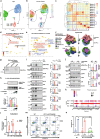p53-inducible lncRNA LOC644656 causes genotoxic stress-induced stem cell maldifferentiation and cancer chemoresistance
- PMID: 40410129
- PMCID: PMC12102190
- DOI: 10.1038/s41467-025-59886-w
p53-inducible lncRNA LOC644656 causes genotoxic stress-induced stem cell maldifferentiation and cancer chemoresistance
Abstract
Genotoxic stress-induced stem cell maldifferentiation (GSMD) integrates DNA damage responses with loss of stemness and lineage-specific differentiation to prevent damaged stem cell propagation. However, molecular mechanisms governing GSMD remain unclear. Here, we identify the p53-induced long non-coding RNA LOC644656 as a key regulator of GSMD in human embryonic stem cells. LOC644656 accumulates in the nucleus upon DNA damage, disrupting pluripotency by interacting directly with POU5F1 and KDM1A/LSD1-NuRD complexes, repressing stemness genes, and activating TGF-β signaling. Additionally, LOC644656 mitigates DNA damage by binding DNA-PKcs and modulating the DNA damage response. In cancer, elevated LOC644656 correlates with poor patient survival and enhanced chemoresistance. Our findings demonstrate that LOC644656 mediates stemness suppression and resistance to genotoxic stress by coordinating DNA damage signaling and differentiation pathways. Thus, LOC644656 represents a potential therapeutic target for overcoming chemoresistance and advancing stem cell biology.
© 2025. The Author(s).
Conflict of interest statement
Competing interests: The authors declare no competing interests.
Figures







Similar articles
-
DNA-damage orchestrates self-renewal and differentiation via reciprocal p53 family and Hippo/Wnt/TGF-β pathway activation in embryonic stem cells.Cell Mol Life Sci. 2025 Jan 6;82(1):38. doi: 10.1007/s00018-024-05561-0. Cell Mol Life Sci. 2025. PMID: 39762370 Free PMC article.
-
The cisplatin-induced lncRNA PANDAR dictates the chemoresistance of ovarian cancer via regulating SFRS2-mediated p53 phosphorylation.Cell Death Dis. 2018 Oct 30;9(11):1103. doi: 10.1038/s41419-018-1148-y. Cell Death Dis. 2018. PMID: 30375398 Free PMC article.
-
ROS-mediated genotoxic stress is involved in NaAsO2-induced cell cycle arrest, stemness enhancement and chemoresistance of prostate cancer cells in a p53-independent manner.Ecotoxicol Environ Saf. 2021 Jan 15;208:111436. doi: 10.1016/j.ecoenv.2020.111436. Epub 2020 Oct 9. Ecotoxicol Environ Saf. 2021. PMID: 33039867
-
SOX2 and p53 Expression Control Converges in PI3K/AKT Signaling with Versatile Implications for Stemness and Cancer.Int J Mol Sci. 2020 Jul 11;21(14):4902. doi: 10.3390/ijms21144902. Int J Mol Sci. 2020. PMID: 32664542 Free PMC article. Review.
-
Translating DNA damage into cancer cell death-A roadmap for E2F1 apoptotic signalling and opportunities for new drug combinations to overcome chemoresistance.Drug Resist Updat. 2010 Aug-Oct;13(4-5):119-31. doi: 10.1016/j.drup.2010.06.001. Epub 2010 Aug 1. Drug Resist Updat. 2010. PMID: 20675184 Review.
References
-
- Mandal, P. K. & Rossi, D. J. DNA-damage-induced differentiation in hematopoietic stem cells. Cell148, 847–848 (2012). - PubMed
-
- Wang, J. et al. A differentiation checkpoint limits hematopoietic stem cell self-renewal in response to DNA damage. Cell148, 1001–1014 (2012). - PubMed
-
- Vousden, K. H. & Prives, C. Blinded by the Light: The growing complexity of p53. Cell137, 413–431 (2009). - PubMed
MeSH terms
Substances
Grants and funding
- 22300325/Ministry of Education, Culture, Sports, Science and Technology (MEXT)
- 19H03708/Ministry of Education, Culture, Sports, Science and Technology (MEXT)
- 21H02974/Ministry of Education, Culture, Sports, Science and Technology (MEXT)
- 23H02809/Ministry of Education, Culture, Sports, Science and Technology (MEXT)
- 24K10279/Ministry of Education, Culture, Sports, Science and Technology (MEXT)
- 22K08644/Ministry of Education, Culture, Sports, Science and Technology (MEXT)
- 22K07205/Ministry of Education, Culture, Sports, Science and Technology (MEXT)
- 22K08619/Ministry of Education, Culture, Sports, Science and Technology (MEXT)
- 21K08524/Ministry of Education, Culture, Sports, Science and Technology (MEXT)
- 20K08397/Ministry of Education, Culture, Sports, Science and Technology (MEXT)
- 20K07561/Ministry of Education, Culture, Sports, Science and Technology (MEXT)
- 19K07635/Ministry of Education, Culture, Sports, Science and Technology (MEXT)
- 19K08972/Ministry of Education, Culture, Sports, Science and Technology (MEXT)
- 18K07439/Ministry of Education, Culture, Sports, Science and Technology (MEXT)
- 18K08464/Ministry of Education, Culture, Sports, Science and Technology (MEXT)
- 21K19398/Ministry of Education, Culture, Sports, Science and Technology (MEXT)
- 23K17429/Ministry of Education, Culture, Sports, Science and Technology (MEXT)
- JPJSCCA20200006/MEXT | Japan Society for the Promotion of Science (JSPS)
LinkOut - more resources
Full Text Sources
Medical
Research Materials
Miscellaneous

